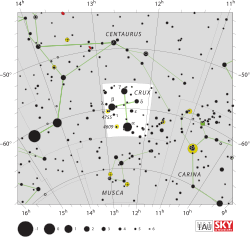Lambda Crucis
From Wikipedia, the free encyclopedia

Location of λ Crucis (circled) | |
| Observation data Epoch J2000 Equinox J2000 | |
|---|---|
| Constellation | Crux |
| Right ascension | 12h 54m 39.1821s[1] |
| Declination | −59° 08′ 48.124″[1] |
| Apparent magnitude (V) | 4.602[2] |
| Characteristics | |
| Spectral type | B4 Vne[2] |
| U−B color index | –0.60[3] |
| B−V color index | –0.15[3] |
| Variable type | Beta Cephei[4] |
| Astrometry | |
| Radial velocity (Rv) | 12[5] km/s |
| Proper motion (μ) | RA: –33.35[1] mas/yr Dec.: –14.75[1] mas/yr |
| Parallax (π) | 9.06 ± 0.60[1] mas |
| Distance | 360 ± 20 ly (110 ± 7 pc) |
| Absolute magnitude (MV) | –1.2[6] |
| Details | |
| Mass | 5.0 ± 0.1[7] M☉ |
| Luminosity | 790[6] L☉ |
| Surface gravity (log g) | 4.00[6] cgs |
| Temperature | 15,800[6] K |
| Rotational velocity (v sin i) | 341[8] km/s |
| Age | 53.3 ± 8.1[7] Myr |
| Other designations | |
Lambda Crucis (λ Crucis / λ Cru) is a star in the southern constellation Crux. The star is classified as a blue-white dwarf (spectral class B4 Vn). The apparent magnitude of λ Crucis is 4.6, but it is not stable. The star is a β Cephei-type variable, and its brightness varies with an amplitude of 0.02m period being 0.3951 days.[4] λ Crucis is located at 360 light-years from the Sun.
This star is a proper motion member of the Lower-Centaurus Crux sub-group in the Scorpius-Centaurus OB association, the nearest such association of co-moving massive stars to the Sun.[6]
References
- ↑ 1.0 1.1 1.2 1.3 1.4 Perryman, M. A. C. et al (April 1997). "The HIPPARCOS Catalogue". Astronomy & Astrophysics 323: L49–L52. Bibcode:1997A&A...323L..49P.
- ↑ 2.0 2.1 2.2 "SIMBAD Astronomical Database". Centre de Données astronomiques de Strasbourg. Retrieved 2007-01-04.
- ↑ 3.0 3.1 Johnson, H. L.; Iriarte, B.; Mitchell, R. I.; Wisniewskj, W. Z. (1966). "UBVRIJKL photometry of the bright stars". Communications of the Lunar and Planetary Laboratory 4 (99). Bibcode:1966CoLPL...4...99J.
- ↑ 4.0 4.1 Samus, N. N.; Durlevich, O. V.; et al. (2004). "Combined General Catalogue of Variable Stars (GCVS4.2)". Retrieved 2007-01-04.
- ↑ Evans, D. S. (June 20–24, 1966). "The Revision of the General Catalogue of Radial Velocities". In Batten, Alan Henry; Heard, John Frederick. Determination of Radial Velocities and their Applications, Proceedings from IAU Symposium no. 30. University of Toronto: International Astronomical Union. Retrieved 2009-09-10.
- ↑ 6.0 6.1 6.2 6.3 6.4 de Geus, P. T.; de Zeeuw; Lub, J. (June 1989), "Physical parameters of stars in the Scorpio-Centaurus OB association", Astronomy and Astrophysics 216 (1-2): 44–61, Bibcode:1989A&A...216...44D
- ↑ 7.0 7.1 Tetzlaff, N.; Neuhäuser, R.; Hohle, M. M. (January 2011), "A catalogue of young runaway Hipparcos stars within 3 kpc from the Sun", Monthly Notices of the Royal Astronomical Society 410 (1): 190–200, arXiv:1007.4883, Bibcode:2011MNRAS.410..190T, doi:10.1111/j.1365-2966.2010.17434.x
- ↑ Uesugi, Akira; Fukuda, Ichiro (1970). "Catalogue of rotational velocities of the stars". Contributions from the Institute of Astrophysics and Kwasan Observatory (University of Kyoto). Bibcode:1970crvs.book.....U.
| ||||||||||||||||||||
This article is issued from Wikipedia. The text is available under the Creative Commons Attribution/Share Alike; additional terms may apply for the media files.